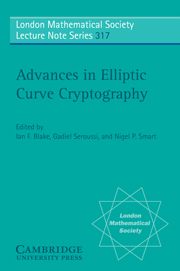Book contents
- Frontmatter
- Contents
- Preface
- Abbreviations and Standard Notation
- Authors
- Part 1 Protocols
- Part 2 Implementation Techniques
- Part 3 Mathematical Foundations
- Part 4 Pairing Based Techniques
- Chapter IX Pairings
- Chapter X Cryptography from Pairings
- Bibliography
- Summary of Major LNCS Proceedings
- Author Index
- Subject Index
Chapter X - Cryptography from Pairings
Published online by Cambridge University Press: 20 August 2009
- Frontmatter
- Contents
- Preface
- Abbreviations and Standard Notation
- Authors
- Part 1 Protocols
- Part 2 Implementation Techniques
- Part 3 Mathematical Foundations
- Part 4 Pairing Based Techniques
- Chapter IX Pairings
- Chapter X Cryptography from Pairings
- Bibliography
- Summary of Major LNCS Proceedings
- Author Index
- Subject Index
Summary
Introduction
This chapter presents a survey of positive applications of pairings in cryptography. We assume the reader has a basic understanding of concepts from cryptography such as public-key encryption, digital signatures, and key exchange protocols. A solid grounding in the general area of cryptography can be obtained by reading [240].
We will attempt to show how pairings (as described in Chapter IX) have been used to construct a wide range of cryptographic schemes, protocols and infrastructures supporting the use of public-key cryptography. Recent years have seen an explosion of interest in this topic, inspired mostly by three key contributions: Sakai, Ohgishi and Kasahara's early and much overlooked work introducing pairing-based key agreement and signature schemes [284]; Joux's three-party key agreement protocol as presented in [183]; and Boneh and Franklin's identity-based encryption (IBE) scheme built from pairings [38]. The work of Verheul [335] has also been influential because it eases the cryptographic application of pairings. We will give detailed descriptions of these works as the chapter unfolds. To comprehend the rate of increase of research in this area, note that the bibliography of an earlier survey [273] written in mid-2002 contains 28 items, while, at the time of writing in early 2004, Barreto's website [15] lists over 100 research papers.
- Type
- Chapter
- Information
- Advances in Elliptic Curve Cryptography , pp. 215 - 252Publisher: Cambridge University PressPrint publication year: 2005
- 27
- Cited by



